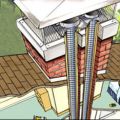12/14/2015
Learn all About Wood Stove Installation
6/14/2016
If you are looking to heat up a part of your house without spending a lot of money, a wood stove is a great option. These types of stoves are often uses as an inexpensive source of energy, while also adding a rustic feel to the home. However, it is very important that you are careful with wood stove installation, because the process can be dangerous if handled improperly.
For those who have decided on wanting a wood stove in their home, here is a look at the steps involved in installing a wooden stove.
1. Location
A lot of people make the mistake of ordering their wood stove before they know where it is going to go. This is not a regular piece of furniture or a small appliance. Some wood stoves are close to 500 pounds, making them incredibly difficult to maneuver. They require a specific type of space in the house where you can keep the stove safely and securely.
If you want the wooden stove for heating purposes, think about keeping it somewhere on your first floor and near the area where you spend most of your time. There is no point having the stove in one corner of your house, if you are always in the other part of the home. For any wood stove installation project, efficiency and insulation are key components. If your stove is installed in a badly insulated room, you will lose a lot of heat and end up using unnecessarily high amounts of energy.
2. Clearance Rating
Wood stoves are extremely hot, which means they should not be placed right next to other appliances or furniture. If you place your stove right next to other items, there is a good chance it will burn something. Speak with a professional about the specific stove you want and whether it is safe for a certain spot in your home.
The clearance rating of a stove is important, because it indicates the amount of space the stove needs from other appliances or even your floors and walls. If you ignore the clearance rating, your stove is a definite fire hazard in the short and long-term.
3. Certification
Make sure you are not getting an uncertified stove. A certified stove is one that is approved through certain safety and environmental conditions. Not only are you likely to get an inefficient stove if you go uncertified, but it is potentially dangerous to have around your house.
4. Correct Size
If you only have a small space that requires heating, you do not need a gigantic wood stove to get the job done. Similarly, you need to take into account the amount of space you can create for the stove. Speak with a professional who can assess your home and your needs before recommending a stove size.
5 Identify the Authorities.
If you are starting a wood stove installation project, it is important to speak with someone from your local government. This is a courtesy to check in on any potential legal and safety regulations regarding wood stoves. Every town and city has their own rules, which makes it a lot more efficient to get this out of the way before you start construction or placement of the stove. There are cases where a building permit is required for the legal addition of a wood stove. In other cases, you might not have to deal with much paperwork at all.
6. Hire a Professional
A wooden stove can become a dangerous object if you do not know what you are doing. This is a giant appliance that has one purpose: to generate heat. If it is installed correctly, wood stoves are 100 percent safe. However, a poor installation can lead to serious problems down the road. If you are investing in a wood stove, you want it installed properly.
Speak with a professional company that specializes in the selection and installation of wood stoves. They can recommend a stove model for your needs and help you get it installed. Even after the stove is installed, you might want to consider periodic inspections to make sure everything is running properly. It is worth your family and home’s safety to pay a little extra for periodic inspections.
Source: Click Here
Other articles and publications:
Wood stove installation requires knowledge from many disciplines. You may elect to use an existing fireplace or to install stovepipe (and insulated pipe) connections.
The knowledge of local codes and NFPA practices is required of anyone installing heating and cooling equipment (HVAC). Select a vendor who is familiar with all types, if not all brands.
12/22/2015
Unlined chimneys are dangerous. Liners are a simple “fix”, but before you get a chimney liner installation, have that chimney professionally inspected for safety.
12/29/2015
The selection of a firm to clean your chimney is important. A chimney is actually a system of interactions between a source of heat and the natural laws of thermodynamics.
3/28/2016
When selecting a firm to do your fireplace service, ensure that your selection can handle the fire safety evaluations, the masonry projects that may be necessary, plus have the installation knowledge
12/7/2015
Many factors affect the integrity of a chimney, including the shifting of land and the inclement weather. Masonry repair may be needed, particularly for deterioration due to weather.
2/16/2016





